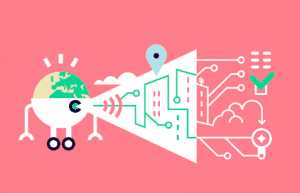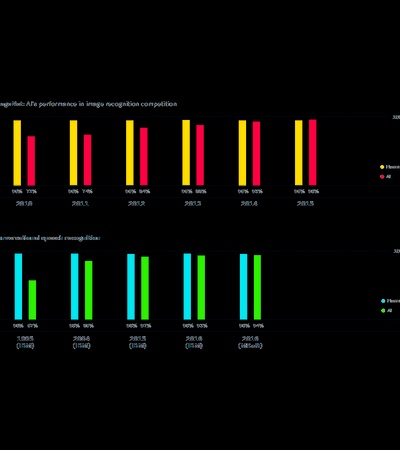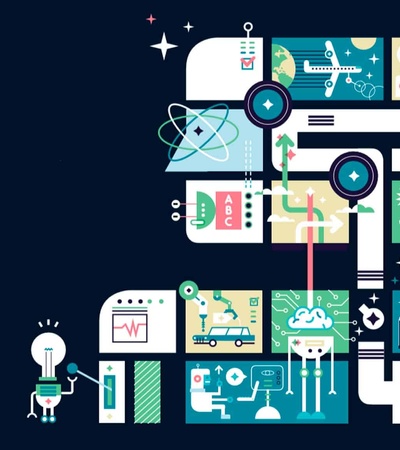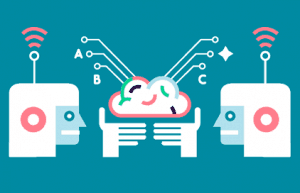Buy one, get a lot: machines take over advertising
### Coming up with a headline that is both informative and attention-grabbing is not easy. Trust me, I have worked on the headline here more than I have worked on the article itself. You want something that lures people in, that keeps them on the page, but is also not seen as click-bait.

And not only headlines, but email subject lines and website layouts, to name a few, says Paul Roetzer, CEO of PR20/20 and founder of the Marketing Artificial Intelligence Institute, a project that aggregates information on AI through interviews with the companies actually developing the tech. Let’s take the example of a person who runs a cooking blog in which recipes are the main content, to understand how companies will use artificial intelligence to know you better. Historically, says Roetzer, to present the right recipes to the right consumers, the blogger would have to manually tag each recipe and its associated picture (for example, ‘pasta’ or ‘French’ or ‘breakfast’). “Now with the use of image recognition software, AI will automatically understand what is in the images and automatically tag those,” he says. “Then the AI, based on a consumer’s past views and the views of other like-minded consumers can present other recipes that it thinks that consumer will like.”
This targeting is also used for sentiment analysis, a category in which the advertising industry, especially the likes of Google and Facebook, is spearheading much of the research, says Raghu Raja, founder and CEO of CrossCues Corp., which is developing machine learning (a type of AI) software for financial institutions’ marketing systems.
Sentiment analysis allows machines to create psychological profiles on people, figuring out who they are, what they like and don’t like, whether they are a Republican or Democrat, and even whether they believe in global warming, so the company can place the right ads in their view.
“Surprisingly, AI will enable marketing to know you better than you know yourself with psychographics,” says David Vandegrift, an AI expert and venture capitalist.
At which point, brand managers’ ears really prick up.
What lives in the digital realm — such as browsing history and pictures — is not the only thing AI can analyze. AI systems that watch and listen to the person in front of it have also been developed and are allowing advertisers to gain insight into consumers’ emotions through facial movements and even conversation tone. This can be extremely beneficial for advertisers to gauge an idea of how their brand appeals to consumers. And this can be done for each ad campaign as well, with AI systems assessing which aspects of an advertisement resonate with what demographic of users. According to Raja, large consumer brands such as Procter & Gamble and Pepsi have undertaken AI machine learning for brand sentiment analysis.
“Now that AI can learn, it can learn about you and customize your experience with a brand in a way no human could”Paul Roetzer, CEO of PR20/20
Plus, machine learning can help brands identify their best customers. Amplero, a Seattle-based predictive analytics platform, launched a machine learning tool in January that allows brands to not only find their most influential customers, but also understand how to optimize a brand’s interactions with them.
EXPERTS PREDICT THAT THE SIZE OF THE ARTIFICIAL INTELLIGENCE ANALYTICS MARKET WILL BE:
- $70 BILLION BY 2020(an increase of more than $61 billion)SOURCE: PWC
Although, there’s one large hurdle. “AI still needs massive amounts of data to be really good and an immense amount of human supervision and training,” explains Roetzer.
For instance, training an AI to learn the difference between a cat and a dog would mean showing the machine millions of images of a cat and millions of images of a dog. The machine learns based on a huge list of variables and tons of time-intensive and costly human reinforcement. Just think how hard
it would be for you to explain to someone that had never seen a cat or dog before what each of those animals was so that when they saw a picture they could be sure of making the correct choice.
“AI will enable marketing to know you better than you know yourself”David Vandegrift, AI expert
What machine learning AI is really good at today and where it will disrupt advertising in the near to mid-term was summed up perfectly by Chris Pierantozzi, executive creative director at global communications company Saatchi & Saatchi, in an interview with Ad Age. AI, he said, “allows us to scale the content as well. Because an AI is able to come up with thousands and thousands and thousands of things, versus [the fact that] it would take a person significantly longer.”
So humans create and the AI replicates.
This was seen in a recent targeted digital campaign by Saatchi & Saatchi for Toyota using IBM’s Watson, a question-answering computer that uses a fair share of artificial intelligence processes, to pair activities that are not usually paired together so that the car company could make unique videos for its audience.

Security analysts at IBM X-Force Command Center are using Watson to augment their investigations into cybersecurity incidents. (John Mottern/ Feature Photo Service for IBM. Courtesy of International Business Machines Corporation.)
The Associated Press and the Orlando Magic also use AI to write thousands of pieces of personalized content within seconds. Both businesses use Automated Insights — the Associated Press to write earnings reports and the Orlando Magic to create personalized emails to stimulate fan engagement.
These machine learning systems that help advertisers personalize their content to specific groups are mushrooming from these campaigns, mostly because these Minority Report-like ads are the really sexy innovation. But it is still generations away, according to Roetzer. “If someone came to me with $1 million to disrupt marketing, my belief in 2012 was to use AI to figure out how best to spend that $1 million. And today it’s not impossible, but it’s a wildly complicated thing to achieve,” he says. “There are so many variables and no one is even close to doing it; I’d be shocked if anyone gets closer in the near future.”
In the meantime, it could be important to have a conversation about AI’s creep factor.
“For AI to be really good it needs access to everything — where you are, what you’re doing, the last thing you asked; it needs as much information as possible,” Roetzer says. “Yet, the assumption about privacy is that the convenience will override people’s concerns about privacy going forward. Privacy becomes a secondary concern for people, although that might backfire eventually.”
According to Raja, regulators are pushing for the elimination of certain types of data, such as race and location, from AI systems. Yet, he wonders whether even that will help. “Whether we like it or not, the small things we do are very good indicators of who we are,” he says.
“If we don’t collect data that’s infringing on people’s private life, than it can’t be utilized to target consumers,” said Michael Green, founder and chief analytics officer at Blackwood Seven. “It’s more a data security issue than an AI issue.”
A data security issue that not only has to tiptoe the line between creepy and valuable, but also puts companies that store this data at risk of attack. The more data stored in a centralized data warehouse, the more alluring that warehouse then becomes for hackers and fraudsters to try and infiltrate.
“There needs to be a recognition that data for data’s sake isn’t always a positive thing in terms of the end user experience,” says Sumeet Vermani, a digital marketing expert who currently works for a financial services and compliance technology company in the UK. “If you’re going to hold data, there’s an inherent risk and cybersecurity threats.” —
TAKEAWAYS MACHINES TAKE OVER ADVERTISING
MUCH OF THE INNOVATION IN THE DEVELOPMENT OF AI, ESPECIALLY AS REGARDS SENTIMENT ANALYSIS, HAS BEEN SPURRED BY THE ADVERTISING INDUSTRY
WHILE AI IS HELPING MAKE ADS MORE PERSONAL AND IN TURN MORE RELEVANT TO SPECIFIC GROUPS, THE TECHNOLOGY IS STILL FAR BEHIND THE PROMISES OF THE ONE-TO-ONE INTERACTIONS SEEN IN SCIENCE FICTION
I’ll be back… (AI in reality)
Synthetic skin peeled away to reveal a red eye glowing inside a metal socket… It would be an unsettling sight, much like it was in the 1984 science fiction film, The Terminator. And while this is the mental image many people concoct when they think AI, that is actually, thankfully, pretty far from the reality.
“There’s a gap between people’s perception and the reality of AI,” says Vandegrift. Most of the AI available today is not a humanlike entity that can relate to “real” humans on a personal level, but instead is narrow or weak AI, a non-sentient AI that is focused on one specific task, he explains. Google’s search engine, for instance relies heavily on narrow AI, although an everyday person does not even register that as AI. This disparity has produced a confusing collection of overlapping definitions for artificial intelligence, machine learning and neural networking systems.
But in many expert’s minds, the industry is broken down like this:
AI is the umbrella term broadly defined as making machines smarter. Machine learning, in which a machine writes its own algorithms and finds its own path to complete tasks is a type of AI. And further under the category of machine learning is deep learning, which employs neural networks — a computer system modeled on the human brain and nervous system — to teach a machine to think like a human.
According to Roetzer, when you upload a group photo to Facebook and it knows who to tag, that is deep learning using image recognition. Plus Facebook’s deep learning image recognition systems have been successful at generating captions that are used to help describe photos to people that are visually impaired.
Much of the attention the AI industry receives today can be linked back to breakthroughs in image recognition in 2012, says CrossCues’ Raja. That technology was then expanded into voice recognition and natural language processing when Siri, Alexa and Cortana were born; and video analysis, which was developed to determine people’s emotions as they browse a webpage, he says.
“There’s a gap between people’s perception and the reality of AI”David Vandegrift, AI expert
Because of this spike in popularity and the amount of new enthusiasts with varying degrees of technical proficiency, convoluted definitions have allowed entrepreneurs and startups to categorize technology as AI, when in fact, it is not, says Vandegrift. For instance, many chatbots, including MotionAI (which uses the term in its name) are referred to as AI, but in fact these products use commandbased software. The difference is that many chatbots use prescripted, menu-based algorithms like consumers hear when calling customer support. Press 1 for hours and directions. Press 2 to speak to a representative. “You’re not typing in ‘How are you?’ and [the computer] comes up with a cogent response,” Vandegrift says about many chatbots.
Since 2010, image recognition software using artificial intelligence has improved substantially.
According to davidvandegrift.com AI-based systems recognized...
- 72OF IMAGES DURING THE IMAGENET COMPETITION IN 2010
- 96OF IMAGES DURING THE IMAGENET COMPETITION IN 2015
But one of the biggest obstacles for fully realizing the power of AI is the fact that many entrepreneurs and startups are focusing on developing oneoff AI tools, where instead the target should be building a whole platform — admittedly not an easy task for startups with their limited amounts of customer data. “AI can excel within those companies that own really unique sets of data, organizations with a ton of proprietary data so it’s constantly learning, which is why Google, Facebook and Apple are the leaders,” says Roetzer.
“The velocity of acquisition in this space will be unreal in the next few years”
Paul Roetzer CEO of PR20/20 and founder of the Marketing Artificial Intelligence Institute
In the advertising sector, Marketo and HubSpot are two companies where developing an AI platform would make sense, he says, mentioning that he worked with HubSpot several years ago on marketing automation. Yet, “a lot of venture capital money is pouring into AI companies building tools, so the velocity of acquisition in this space will be unreal in the next few years.” This platform trend aided by acquisition has already begun. In September 2016, Salesforce launched Salesforce Einstein, an AI platform for the company’s business clients, after acquiring a number of smaller startups focused on AI.—
TAKEAWAYS I’LL BE BACK… (AI IN REALITY)
AI IS FAR LESS FANTASTIC AND FRIGHTENING THAN THE TERMINATOR. WITHOUT KNOWING IT, WE INTERACT WITH AI SYSTEMS DAILY IN THE DIGITAL REALM
AI PLATFORMS ARE WHERE THE POWER OF MACHINE INTELLIGENCE WILL BE REALIZED. BUT MOST STARTUPS ARE FOCUSED ON BUILDING SINGULAR TOOLS
BEYOND HUMAN: AI ON THE MARCH

COMMUNICATION TAKEAWAYS
CURRENTLY, AI IS GOOD AT THE REPLICATION OF CREATIVE IDEAS FIRST IMAGINED BY A HUMAN
AI WILL CONTINUE TO DISRUPT THE ADVERTISING INDUSTRY AND NEW ENTRANTS MUST BE PREPARED TO REDEFINE THEIR ROLE AS THEY COLLABORATE WITH MACHINES
AI WILL CHANGE THE ROLES PEOPLE PLAY IN ADVERTISING AND MARKETING, BUT HUMAN CREATIVITY WILL STILL BE VALUABLE
HOUSING SIGNIFICANT AMOUNTS OF CONSUMER DATA COMES WITH INHERENT CYBERSECURITY RISKS
Further reading
- Is Artificial Intelligence Permanently Inscrutable? by Aaron M. Bornstein
- AI, Machine Learning and Deep Learning: A Primer by Frank Chen
- Artificial Intelligence’s White Guy Problem by Kate Crawford
- The Great A.I. Awakening by Gideon Lewis-Kraus
This material has been prepared for general informational purposes only. Some information has been compiled by third party sources that we consider to be reliable. However, we do not guarantee and are not responsible for the accuracy of such. The views of third parties set out in this publication are not necessarily the views of IE University and they should be seen in the context of the time they were made.







